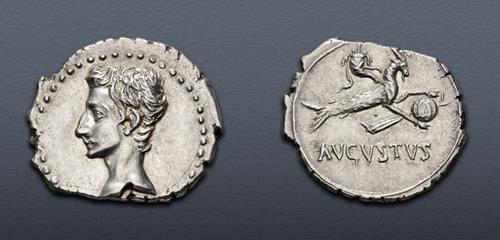|
Augustus. 27 BC-AD 14. AR Denarius (21mm, 3.82 g, 6h). Uncertain Spanish mint (Colonia Patricia?). Struck circa 18-17/16 BC. Bare head left / AVGVSTVS below, capricorn right, holding globe attached to rudder between front hooves; cornucopia above its back. RIC I 130; RSC 22; BMCRE 307-8 (Emerita) = BMCRR Gaul 126-7; BN 1354-7 (Nimes). Faint hairlines. Superb EF. Well struck and fully lustrous.
From the Viggo Collection. Ex Numismatica Ars Classica 64 (17 May 2012), lot 1044 (hammer CHF 10,000).
According to Suetonius, Augustus had been born while the moon was in the sign of Capricorn. Seeing this as a sign of his great destiny, Augustus associated the symbol closely with himself by striking it on coins and incorporating it into numerous works of art, so that it became a standard part of the imperial iconography. In order to legitimize their own claims, his successors periodically employed the capricorn imagery on their own coinage. Adding the cornucopia, or horn of plenty, to the back of the capricorn symbolizes the prosperity brought about by the emperor.
The final winners of all Triton XXVI lots will be determined at the live public sale that will be held on 10-11 January 2023.
Triton XXVI – Session Three – Lots 674-990 will be held Wednesday morning, 11 January 2023 beginning at 9:00 AM ET.
Winning bids are subject to a 22.5% buyer's fee for bids placed on this website and 25% for all others.
We recognize that our users may have various Internet Browsers and Operating Systems. We like our visitors to have the best possible experience when using our bidding platform. However, we do recognize that it is impossible to develop applications that work identically, efficiently and effectively on all web browsers. The CNG bidding platform supports the latest stable major version and stable previous version of Chrome and Firefox.
|
